Gary Chavez is an aerospace engineer by day and a board game designer by night. He lives in Cincinnati, Ohio, with his wife and two daughters, enjoys salsa dancing and writes tips about game design (you can check out Gary’s articles here).
In the first half of a two part interview, we catch up with Gary about his new game, Saints & Scoundrels, which is currently live on Kickstarter. You can read our full review of Saints and Scoundrels.
What’s the 15 second pitch for Saints & Scoundrels?
Saints & Scoundrels is a pulp era detective themed bluffing card game for 2-6 players that plays in about 20-30 minutes. Players are trying to find a serial killer in the city and one man has offered to help them, a man named Dr Xyko aka ‘Dr Xyko The Psycho’. He’s also a serial killer but he’s in jail and he can help you but the rumour is that he would love nothing more than to drive the detectives insane. The object of the game is to gather enough evidence to find the killer without going insane.
You’ve previously said the theme of Saints & Scoundrels was inspired by one of your favourite films and a favourite character, could you tell me about that?
So, I’m downstairs watching TV at 2 o’clock in the morning and The Silence of the Lambs comes on, one of my favourite movies and, of course, I’ve got to watch it. At one point, the FBI director tells Clarice Starling that Hannibal Lecter can help her find the killer but that she doesn’t want to be around him for too long because he’ll drive her crazy. When I heard that something just clicked in my head – I realised that it’s a push-your-luck mechanic and I could make a game out of it. That’s one of my favourite parts – the drama in the movie is Clarice finding the level of risk that she’s willing to take with Hannibal to solve the mystery.
Throughout Saints & Scoundrels that’s what’s happening with the players too, they’re thinking ‘ok how much risk am I willing to take to win this game’. Every time someone makes a move, the game changes and everyone recalculates how much risk they’re willing to take. It’s so interesting to see people at one point feel safe that their strategy is working and then suddenly they think ‘oh, now I gotta take more risk to win this game’. Throughout the game you’re calculating your own comfort level.

My understanding is that you don’t get to look at the Dr Xyko cards you pick up until the very end?
Exactly. Most cards you play will allow you to move 2-4 spaces along the evidence track (reaching the end of the evidence track means you’ve gathered enough evidence to find the killer). But visiting Dr Xyko allows you to move 7 spaces, which is huge, but you also have to take 2 Dr Xyko cards. Half of them are blank, a little bit less than half of them have 1 insanity icon and 2 of them have 2 icons. If you finish the game with 3 icons then you’ve gone insane. I’ve calculated that if you visit twice you’ll have about a 35% chance of going insane from your 4 cards… but you don’t get to look at these cards until the end of the game.
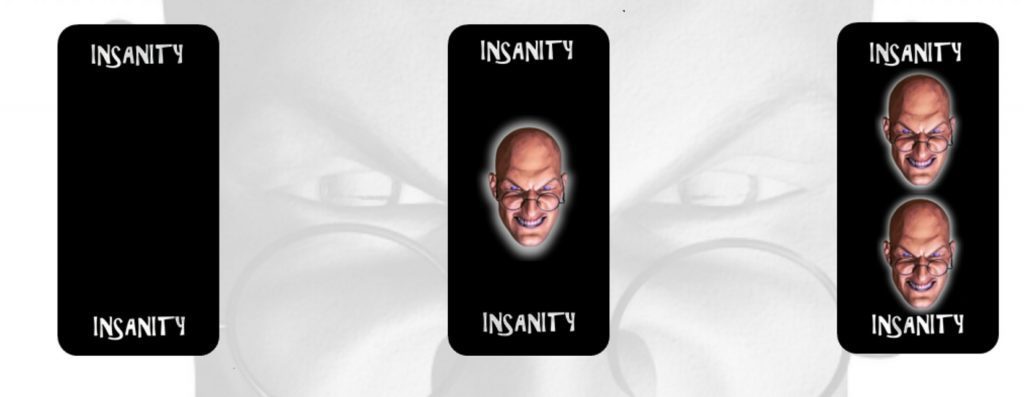
So it’s how much risk are you willing to take? What I love about the mechanic is that you have the average chance but there’s a large range of deviation from that – there’s maths and then there’s reality. I’ve seen people get 6 or 8 Dr Xyko cards and they don’t go insane, yet in one game I only visited once and I got both double insanity cards! It’s the climax of the game – we know who’s 1st, 2nd and 3rd but when everyone reveals their insanity cards everything could change.
Can you tell me about the development process for Saints & Scoundrels?
It’s been 2 years since I saw that movie. The game itself came together in about a year. Actually, it began more like a game of Werewolf. That’s such a great game, I love the simplicity of it. I was trying to find a way to add the push-your-luck Dr Xyko mechanic and it didn’t quite work so I finally came up with the idea that is more like Saints & Scoundrels now.
As I moved along with the development, I began to think about the publishing options and I thought this would be a good game to Kickstart – it’s on the less expensive side, appeals to a wider audience and the components are simple. I decided to take my time to understand the Kickstarter process, talk to people and start to build my audience. So it’s been 2 years but only half of that has been development, the other half has been marketing. You really need to bring the crowd to ‘crowd funding’, otherwise you won’t get a lot of support.
What’s the best response you’ve had whilst promoting the game Saints & Scoundrels?
I just got back from Gen Con in Indianapolis where I had a giant version of Saints & Scoundrels which went over great. I think nowadays – especially at a big convention like Gen Con where there’s so much competition for someone’s time – you really need to grab people’s attention and present them with a unique experience that they can’t get anywhere else and the giant sized version of Saints & Scoundrels offered that. It had a presence, it took up the length of two 8 foot tables and had 12-15 inches tall standees so you could see from 15-20 feet away. I also had the idea of coloured fedoras which were $2 at a party store. They went well with the theme but were also a good way to show player colour. People immediately got into character, starting to role-play as soon as they put the hats on.
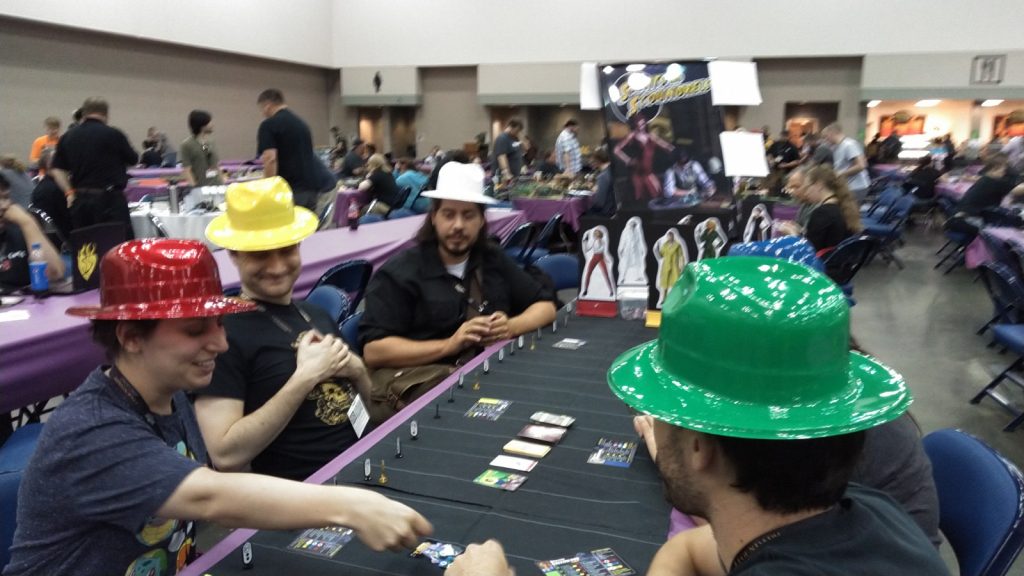
One of the things I like about Sheriff of Nottingham is that role-playing just happens, it’s spontaneous. It’s not necessary for Saints & Scoundrels but it’s such a fun thing to do and it happened very naturally with the giant version. It was very fun to watch, seeing good friends speaking as if they were in a pulp detective novel and accusing each other of lying!
As well as designing the game, you’ve done the art for Saints & Scoundrels?
Yes, actually Saints & Scoundrels was originally going to be FBI agents but I did the art and it wasn’t very inspiring so I asked myself what inspires me? I’ve always liked pulp art – it’s so dramatic and gritty. I love it that one picture tells a story and I wanted that to happen too in Saints & Scoundrels – you look at a card and it’s telling a story. It helps you feel more in the world of Saints & Scoundrels.
Was it intentional to make the cards look like old book covers?
Yes, that was a fun part to do, to make them look like a cover, like something you’d find 50 years ago. You worry as a designer whether some of your artistic ideas are going to interfere with the game play but in this case it doesn’t, people understand immediately what’s trying to be said. Sometimes things just work out.
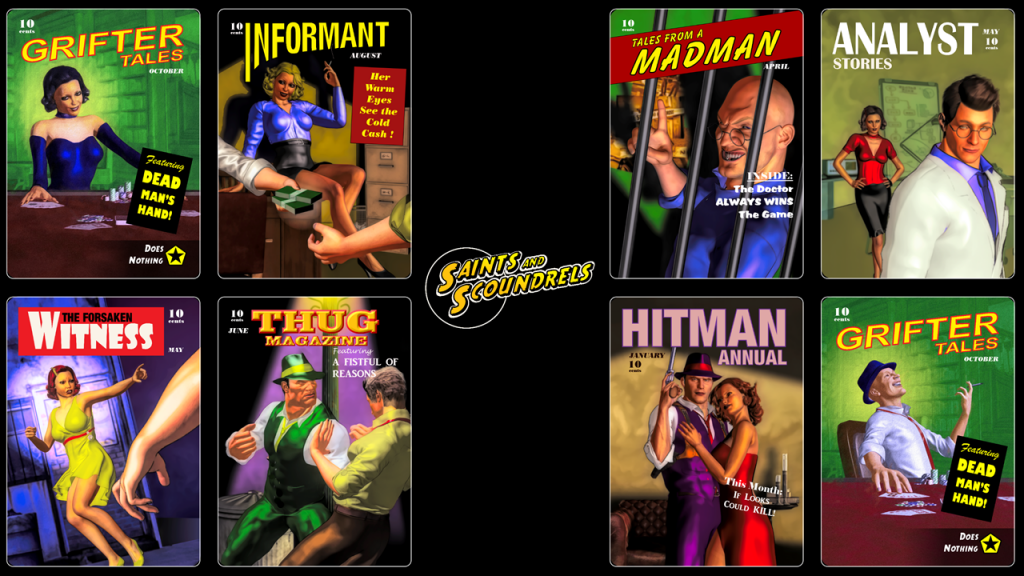
The game is 2-6 players, a nice player range, how important for making the game work across that range was it, is it different at different player counts?
One of the things I wanted to do was to make a game that you can easily introduce to non-gamers – the scenario I always talk about is that you’re going to a restaurant with some friends and you want something to do for the 20 minutes between ordering and getting your food. And Saints & Scoundrels is perfect for that, it’s a small box, has a very small footprint on the table and you can set up the game in 2 minutes. You can bring it to a restaurant, introduce it to your non-gaming friends, play for 20 minutes until you get your food and you have a great time doing that. And so I thought it needed more than just 4 players. I think it works with 8 players but the components required put it out of the price range for the Kickstarter – you’re adding more cards and pieces and it becomes a bit more expensive than I’d want. But then I also wanted it to work at 2 players because sometimes it’s just you and another person.
I playtested it every way and the rule set is the same for each of them but they do play a little differently. The big difference is that at 6 you have to convince more people that you’re telling the truth, you have to lie a little better. But with 2 people it’s a lot more intimate, there’s a lot more you can do to try to figure out whether your opponent is lying or not. It works at all player counts and I’ve enjoyed 2 player games as much as 6 player games.

How many times do you think you’ve played it?
Wow, hours and hours. Typically I’d say it takes about two to three hundred hours to get a game to the state where it’s marketable and I’d say I’ve played at least two to three hundred hours of Saints & Scoundrels. But that’s a good sign, to be able to play it that much and not get bored. I do enjoy playing it. You run into this as a designer – sometimes a game isn’t the components and the rules, sometimes a game is the social interaction and I think that Saints & Scoundrels every time I play with a new group it’s a new experience, the social interaction is different and it’s fun to interact on that level with new people or old friends. So it’s always a new experience.
Can you tell me a little more about the expansion you’re offering backers at the premium level?
It’s called The Surly Suspects expansion and it’s [only] going to be offered at the premium level. One of the things I was not quite happy with about the design is that in the game you’re looking for a serial killer but the serial killer itself is kinda in the background – it’s the same with The Silence of the Lambs movie, the serial killer doesn’t really make much of an appearance until the very end and it’s really the interaction between Clarice Starling and Hannibal Lecter that’s the story.
For a designer you don’t want any extra bits – it’s always so tempting to add this extra thing and that extra thing and sooner or later you lose the game in all the stuff you thought it would be fun to add to it. But one thing I didn’t like was that in Saints & Scoundrels you get to the end and there’s no specific serial killer that’s found. The Surly Suspects expansion adds that aspect – at the end you actually find the serial killer and that changes the game play a little bit at the last stage of the game. For me it means the narrative is much more complete.
You have a series of suspects of people who could be the killer and at the beginning of the game you randomly deal one and put it at the end of the board and when someone finds the killer you reveal that card and it just changes the game a tiny bit. The person who gets to the end of the track first has that power, they get options to have one last move in the game to switch it in their favour, it actually motivates someone to get to the end of the track first.
It sounds like you’re giving additional incentives to take the risk of going to see Dr Xyko more?
Sure, that’s a really fun part of designing the game: how can I make people want to see Dr Xyko more? When people first play the game it’s going along smoothly and people understand the process but once the first person goes to see Dr Xyko the game completely changes because the state of the game changes, the calculation changes – the player who was in last place, suddenly they’re in first place and the person who was ahead is now in second and they thought they were going to have an easy win and suddenly they’re not. If that same player decides they want to take another risk to see Dr Xyko then that changes the game even more and so you start to think ‘well maybe I need to go see Dr Xyko before someone else goes to see Dr Xyko’.
The first visit just sparks a tree of thought processes and it’s fun to see that at the table when that happens. It’s one thing to say you’ll move forward 7 spaces but when you see that last player move their piece up and ahead of everyone else people start to think ‘oh, that just happened, I have to adapt to this’. It’s really fun to see that particular mechanic work and change people’s mind that way.
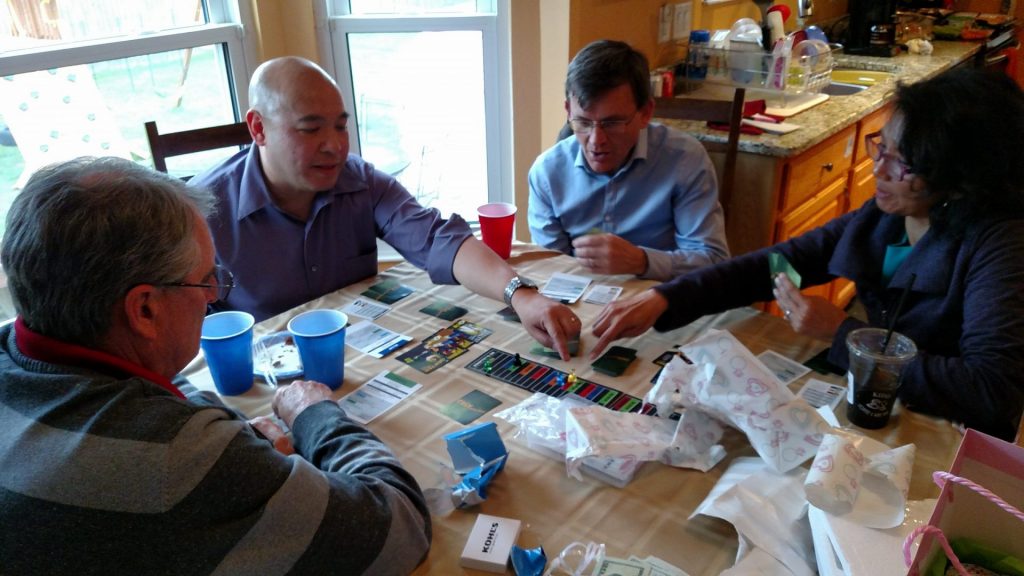
I’m assuming that means they end up lying more and call people’s bluff more?
Sure. I think there are some strategies you can take. There’s a strategy that I took, I was playing with two other people and one person made the move to Dr Xyko and the other person was not having that and so they started to make the move to Dr Xyko as well. I made the calculation and thought that they’d both go crazy so I hung back. When one person reached the end and found the serial killer we turned the cards over and they both ended up going insane and I was still in there so it worked and I won. But there are several strategies and I’ve seen other people take that strategy and it not work so you’re always calculating your level of risk – if I do this what’s my risk of winning vs losing. Sometimes it works and sometimes it doesn’t but that’s the wonderful thing about having a 20 minute game – if it doesn’t work it’s not like you spent too much time, you didn’t spend 4 hours on the strategy or anything, you can simply just play again. People are much more willing to forgive a game for randomness if it’s short.
It seems to be more dependent on what your friends are doing than randomness, you’re playing the room as much as playing your luck?
Sure. And you don’t want to completely get rid of the randomness of the game, especially if it’s a game for casual gamers or non-gamers – they need a way to catch up. So the randomness helps that – you don’t want a game of chess where someone who’s been playing it for years is always going to beat someone who’s new at it. You want the new player to have as much chance to win, and that does happen a lot where a new player ends up winning, you want to have a bit of randomness to even the playing field a little bit. Also to add just a little bit of spice to the game, something happens and you’ve never seen it happen before. I saw someone go to Dr. Xyko and get 8 cards and usually they’d go insane but one guy he did it and when he revealed that last card and he didn’t go insane everyone at the table just exploded. That was the craziest strategy and none of us thought it would work but it worked for him and that was because of the randomness. As long as everyone understands that there’s a randomness that everyone can take advantage of then I think that it’s fine. You don’t want the randomness to just work for one player.

I really like the idea of the expansion, I like that narrative tie. I reviewed Thanos Rising recently and in that you spend all your time trying to delay him from getting the gems and stop his minions but you never really stop him and it makes sense thematically but it’s a bit dissatisfying. I really like the idea that you’ve got this expansion where the main narrative behind the story is now complete.
Yeah, it’s the MacGuffin in the movie almost. For Saints & Scoundrels I think there’s a lot of stuff going on to make it satisfying already but I wanted to do that bit extra for the narrative. Here’s the story going on, here’s what you went through then you found the killer and the killer turned out to be that retired admiral or the museum owner and it’s a story you can tell and I really wanted that to be part of the experience.
Who wins if you are playing Saints & Scoundrels with your wife?
I think I’ve won more times but that’s because the strategy I use is that I tell the truth because I can’t lie to her – she knows exactly when I’m lying and the cards have been such that have supported me telling the truth. If I’d got a bad set of cards I don’t think I’d have been able to win. The night I proposed to her I didn’t say a word, she thought I was mad at her but I knew the moment I said something she would know what was going to happen. She sees right through me, she knows I’m lying before I know I’m lying! Where I am the aerospace engineer in the family and do all sorts of math stuff, her genius is social situations, she sees everything that happens.
Ok, finally, what makes Saints & Scoundrels fun?
There are three reasons this game is fun: 1) it’s fun to lie to your friends; 2) it’s fun to call your friend a liar; 3) and it’s fun to watch one friend call another friend a liar. In a social setting when someone calls someone a liar it doesn’t get resolved right away but in the game it’s resolved in 2 seconds. It’s a drama that happens within a minute or so. It happens every turn and keeps everyone engaged too, as opposed to having too much downtime. There isn’t much downtime in this game because every turn you’re trying to figure out if someone is lying or not. If you can figure that out you have an advantage but if you’re wrong then you’re at a disadvantage! It’s a lot of fun!
It definitely sounds like it, thanks for your time Gary!
Saints & Scoundrels is live on Kickstarter until the 24th October 2019 here, and check back soon for the second half of our interview with Gary where we will be discussing designing board games and taking the plunge with Kickstarter.


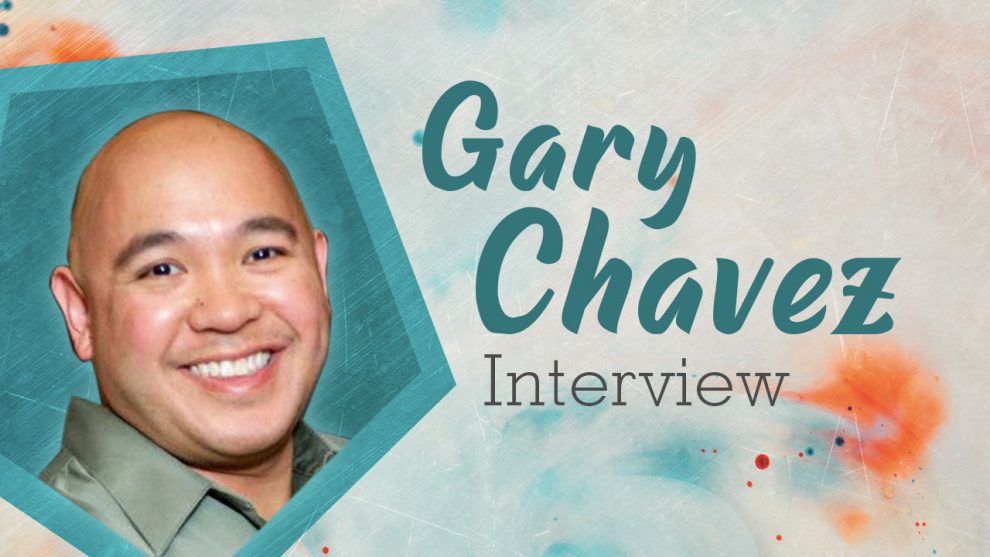
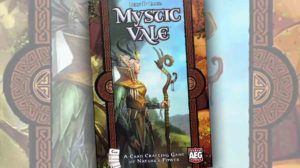
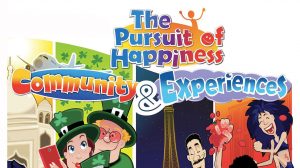
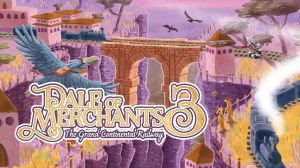





Add Comment